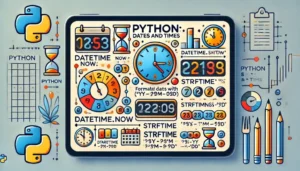Handling dates and times in Python is essential for effective data analysis, scheduling applications, and backend processing. Python’s built-in datetime module provides powerful tools to create, manipulate, and format dates and times. These capabilities enable developers and data analysts to accurately perform calculations, comparisons, and transformations involving date-time objects, simplifying tasks such as scheduling events, calculating durations, and formatting timestamps.
Mastering Python datetime operations significantly enhances your efficiency when managing temporal data, making it a fundamental skill in software development and data analytics. By completing these exercises, you’ll gain proficiency in common date-time operations such as formatting, parsing, arithmetic manipulations, and extracting specific date or time components for targeted use cases.
🚀 Jump Right to Exercise Tasks: Python Exercises – Dates And Times
Creating and Formatting Datetime Objects
Python’s datetime module allows you to create datetime objects representing specific dates and times. You can then format these objects into human-readable strings using built-in methods. This feature is crucial when you need consistent date-time representations across your applications.
Practical Example
Imagine needing to record a fixed event timestamp clearly and consistently:
from datetime import datetime
event_time = datetime(2025, 1, 1, 12, 0, 0)
print(event_time.strftime("%Y-%m-%d %H:%M:%S"))Example Solution:
2025-01-01 12:00:00Key Takeaways:
- Use datetime for precise date and time representations.
- Format datetime objects for clear output.
- Consistency in date formatting aids data readability.
Date Arithmetic and Manipulation
Python makes date arithmetic straightforward, allowing you to add or subtract days, hours, or other time units effortlessly. This capability simplifies calculating future or past dates, durations between events, or adjusting timestamps for analysis.
Practical Example
Consider a scenario where you need to find the date exactly one week from a given day:
from datetime import datetime, timedelta
initial_date = datetime(2025, 1, 1, 12, 0, 0)
new_date = initial_date + timedelta(days=7)
print(new_date)Example Solution:
2025-01-08 12:00:00Key Takeaways:
- timedelta facilitates intuitive date arithmetic.
- Easily calculate future or past dates.
- Useful for scheduling and duration calculations.
Extracting and Replacing Datetime Components
Python allows you to extract individual components from datetime objects (such as year, month, or day) or replace specific parts of the datetime. This is especially helpful in scenarios where precise manipulation or extraction of date and time data is required for reporting or conditional logic.
Practical Example
Suppose you have an existing timestamp and need to adjust only the hour component:
from datetime import datetime
original_datetime = datetime(2025, 1, 1, 12, 0, 0)
updated_datetime = original_datetime.replace(hour=9)
print(updated_datetime)Example Solution:
2025-01-01 09:00:00Key Takeaways:
- Replace individual datetime components quickly.
- Extract specific date-time elements for precise logic.
- Enhances control over datetime manipulations.
What You’ll Gain from Completing This Exercise
By mastering Python’s datetime operations, you’ll learn efficient handling, formatting, parsing, and manipulation of date-time data. This skill set is invaluable for effective programming, precise analytics, and optimized data management, enabling you to confidently tackle complex temporal data challenges.
How to Complete the Exercise Tasks
Use the interactive Python editor provided below each task:
- Write your Python code: Enter your solution into the editor.
- Run your code: Click “Run” to execute and see immediate results.
- Validate your answer: Confirm accuracy with provided tests.
- Reset the editor: Click “Reset” to clear your workspace and start fresh.
Earn XP, Unlock Rewards, and Track Progress!
If logged in, completing tasks grants XP, unlocking new levels, unique Avatars, Frames, and leaderboard positions. Your progress automatically saves, helping you track your skill growth effectively.


